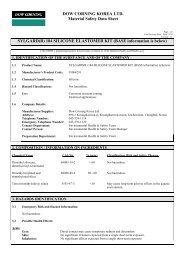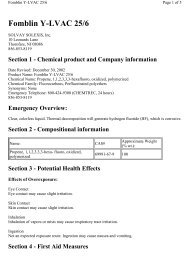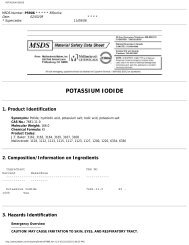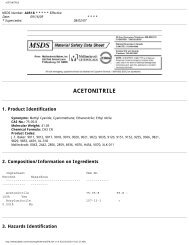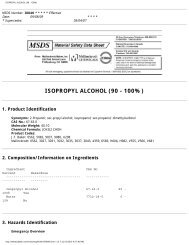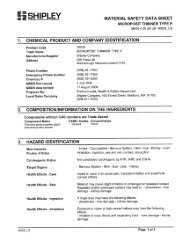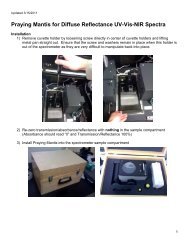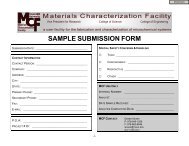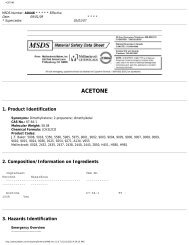ETHYL ALCOHOL COMPLETELY DENATURED
ethyl alcohol completely denatured - Materials Characterization ...
ethyl alcohol completely denatured - Materials Characterization ...
- No tags were found...
You also want an ePaper? Increase the reach of your titles
YUMPU automatically turns print PDFs into web optimized ePapers that Google loves.
<strong>ETHYL</strong> <strong>ALCOHOL</strong> <strong>COMPLETELY</strong> <strong>DENATURED</strong><br />
5. Fire Fighting Measures<br />
Fire:<br />
Flash point: 13C (55F) CC<br />
Autoignition temperature: 363C (685F)<br />
Flammable limits in air % by volume:<br />
lel: 3.3; uel: 19.0<br />
Listed values are for pure ethanol. Flammable Liquid and Vapor!<br />
Explosion:<br />
Sealed containers may rupture when heated. Above the flash point, explosive vapor-air mixtures may be<br />
formed. Vapor may explode if ignited in an enclosed area. Vapors can flow along surfaces to distant ignition<br />
source and flash back.<br />
Fire Extinguishing Media:<br />
Most appropriate extinguishers are carbon dioxide and alcohol-resistant foam. Use water in flooding quantities<br />
as fog. Water spray may be used to keep fire exposed containers cool. Do not allow water runoff to enter<br />
sewers or waterways.<br />
Special Information:<br />
In the event of a fire, wear full protective clothing and NIOSH-approved self-contained breathing apparatus<br />
with full facepiece operated in the pressure demand or other positive pressure mode.<br />
6. Accidental Release Measures<br />
Ventilate area of leak or spill. Remove all sources of ignition. Wear appropriate personal protective equipment<br />
as specified in Section 8. Isolate hazard area. Keep unnecessary and unprotected personnel from entering.<br />
Contain and recover liquid when possible. Use non-sparking tools and equipment. Collect liquid in an<br />
appropriate container or absorb with an inert material (e. g., vermiculite, dry sand, earth), and place in a<br />
chemical waste container. Do not use combustible materials, such as saw dust. Do not flush to sewer! If a leak<br />
or spill has not ignited, use water spray to disperse the vapors, to protect personnel attempting to stop leak, and<br />
to flush spills away from exposures. US Regulations (CERCLA) require reporting spills and releases to soil,<br />
water and air in excess of reportable quantities. The toll free number for the US Coast Guard National<br />
Response Center is (800) 424-8802.<br />
7. Handling and Storage<br />
Protect against physical damage. Store in a cool, dry well-ventilated location, away from any area where the<br />
fire hazard may be acute. Outside or detached storage is preferred. Separate from incompatibles.<br />
Containers should be bonded and grounded for transfers to avoid static sparks. Storage and use areas should<br />
be No Smoking areas. Use non-sparking type tools and equipment, including explosion proof ventilation.<br />
Containers of this material may be hazardous when empty since they retain product residues (vapors,<br />
liquid); observe all warnings and precautions listed for the product. Do Not attempt to clean empty containers<br />
since residue is difficult to remove. Do not pressurize, cut, weld, braze, solder, drill, grind or expose<br />
such containers to heat, sparks, flame, static electricity or other sources of ignition: they may explode and<br />
cause injury or death.<br />
8. Exposure Controls/Personal Protection<br />
Airborne Exposure Limits:<br />
For Ethyl Alcohol:<br />
- OSHA Permissible Exposure Limit (PEL):<br />
http://www.jtbaker.com/msds/englishhtml/E2012.htm (3 of 8) [2/12/2010 4:59:34 PM]



